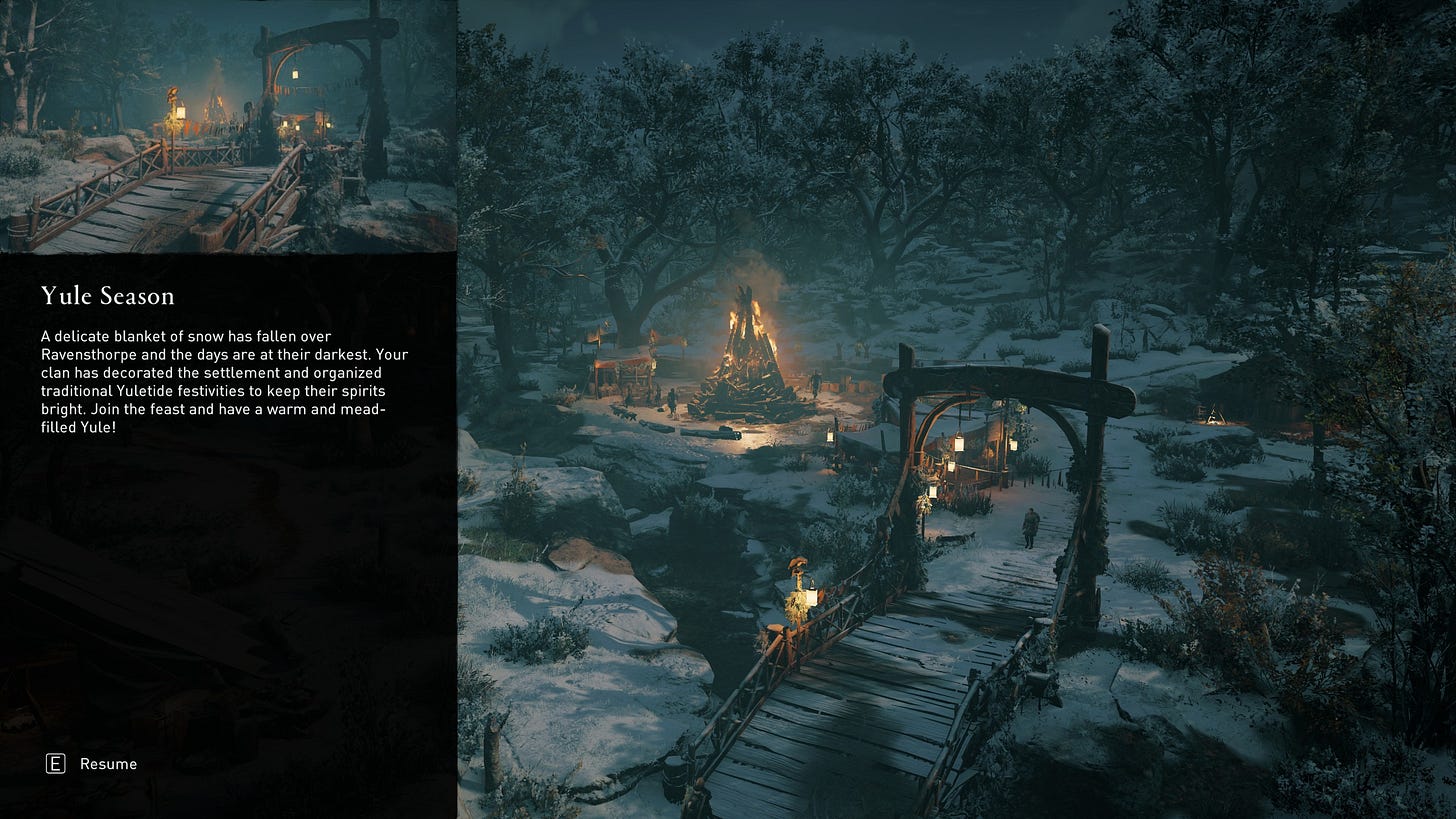Hello, good evening, happy Friday. First I want to say that while next Friday is Christmas, there will still be a newsletter, so you should not worry about that. The content must flow.
This week was very busy and not especially eventful, except that yesterday I decided I would try to buy a PS5 and today I bought one. My hunt lasted a whole 26 hours, and to be honest it was kind of anticlimactic. I figured there would be like, at least a week of hunting, and that I would become increasingly frustrated until I was ultimately victorious. I am just getting… increasingly good at shopping online, I guess.
But those skills will continue to be put to use, because I now have a list of friends who are also trying to get a console for themselves or their loved ones, and I will not rest until they have all reaped a bountiful harvest. The fight goes on! To Valhalla!
Speaking of Valhalla, I am really, REALLY enjoying Assassin’s Creed Valhalla. The more I play, the more I love it.
Does that landscape look aesthetically familiar, and decidedly non-Englandy? Surprise! There’s an entire chapter of the game that you play on the Atlantic coast of North America! I had no idea this was part of the game, but I was thrilled to come upon it, and I enjoyed it very much.
I think that is what I would like to recommend for you this week. Find something to surprise yourself with, or otherwise something that you know you will enjoy very much. You deserve a treat. After all, it’s Yule!
(This is another thing I didn’t know would be part of the game but enjoyed very much.)
What’s in a meme
Every year one of my favorite reporters, Julia Reinstein, writes a meme retrospective. Here’s this year’s. It’s very good:
[Note: This post — the fifth annual in a series! — is a list, not a ranking, so please don't yell at me if your favorite is #33 or whatever. But if you're going to yell at me, please let it be to debate the spelling of "Mi Pan."]
Nothing natural about it
As we have discussed in this newsletter, QAnon is the batshit crazy conspiracy theory that involves the supposed abuse of children in satanic rituals. This week’s new spin on the terrible mind virus is that the “natural birth” community is jumping on board the conspiracy:
Yolande Norris-Clark gazes placidly into the camera, speaking in her best ASMR voice, honey-colored bangs lying flat against her forehead as if stuck there by glue. She is, she says, with her five youngest children (she has eight) in the jungles of Costa Rica, where she’s recently relocated from her home in Canada. “This global reconstruction/ reconfiguration has nothing whatsoever to do with a flu-like illness and it just seems heavier and darker and more constrictive than I could’ve imagined. It’s not about a flu-like illness. It’s never been about a flu-like illness, and I really think the ‘Rona is irrelevant to all of this,” she says.
Norris-Clark is a self-described “writer, birth educator, freebirth coach, [and] iconoclast” who also goes by BauhausWife and is an instructor with the Free Birth Society, a group devoted to unassisted at-home childbirth. “Freebirth” is a term that refers to unassisted childbirth or pregnancy, without the guidance of a doctor, midwife, doula or other trained medical professional. It is distinct from home birth, a term used to describe someone having a baby outside a hospital, but usually with some sort of professional assistance. Home births only comprise a small percentage of the births every year, according to 2019 data; free births make up an even smaller number in the United States, or about a quarter of a percent — less than 10,000 births a year. But these numbers are on the rise thanks in large part to maternal concerns about Covid-19 in hospitals.
In November 2018, the Daily Beast published an investigation into the Free Birth Society after the death of a group member’s baby following a grueling six-day unassisted labor; earlier this year, NBC News also published an expose on the Free Birth Society. But increased media scrutiny has not staunched Norris-Clark’s platform. On Instagram, where she has 28,000 followers, she refers to herself as a “bringer of light,” a variation on “lightworker,” nomenclature that’s associated with QAnon, the baseless conspiracy theory about the existence of a Deep State child sex trafficking ring run by leftists; the term is meant to connote someone who brings light to darkness, or draws awareness to evils lurking in dark corners. She has also posted the #SaveTheChildren hashtag, an anti-trafficking hashtag that was coopted by the movement last summer. On YouTube, she posts lengthy tirades against the authoritarian “Deep State,” another QAnon term. Though she has denied her connection to the movement (“I know absolutely nothing about QAnon,” she said in a response to a Mother Jones article published in September), she has continued to push Q-connected conspiracies like Covid-19 denialism, such as the debunked claim that the novel coronavirus is no more lethal than the seasonal flu, as well as anti-mask content, poking fun at the efficacy of PPE in her Instagram stories.
It’s bad, it’s dangerous, please be on the lookout for stuff like this so you can keep your friends from falling down the rabbit hole before it’s too late.
Boob tube
Sorry, this isn’t an article about boobs, it’s an article about the poor management of YouTube and how a failure to moderate it effectively has caused (and will continue to cause) extreme right-wing radicalization:
In the fall of 2018, I released a research report warning of a growing trend of far-right radicalization on YouTube. Specifically, I identified a loosely connected network of reactionary YouTubers, ranging from mainstream conservatives and libertarians all the way to overt white supremacists and neo-Nazis, who were all broadcasting their political ideas to young audiences. Tethered together by a shared opposition to “social justice warriors” and the mainstream media, they frequently collaborated with each other and amplified each other’s content. In the process, they made it extremely easy for a viewer to move bit by bit into more extremist content.
The following March, I watched in horror along with much of the rest of the world, as a white supremacist gunman killed 51 people and injured 40 more at the Al Noor Mosque and the Linwood Islamic Centre in Christchurch, New Zealand. Throughout the chaos of the day, researchers parsed his manifesto and found that under the layers of irony and memes, the message was quite clear. He had been radicalized to believe in the Great Replacement, a white nationalist conspiracy theory that claims that white populations are being purposefully replaced with (often Muslim) immigrants.
The shooter’s manifesto clearly spelled out his racist and Islamophobic beliefs, but it provided scant information on how he came to embrace them. On Monday, with the release of the Royal Commission’s inquiry into the attacks, we got a fuller picture: the Christchurch shooter was radicalized on YouTube, by many of the propagandists myself and other researchers had warned about. So why didn’t YouTube take action sooner, and what should they be doing now?
Cyberpunk’d
I told you not to play the bad game, and I hope you listened! But lots of people didn’t, and then they got very angry, and rightfully so. But the most righteous anger probably comes from the developers:
Rebellion is in the air at Polish video game publisher CD Projekt SA after the company’s highly anticipated, and thrice-delayed, latest title was released to scathing reviews about glitches.
Frustrated and angry staff fired questions at the board during an internal video meeting Thursday that opened with management apologizing for Cyberpunk 2077’s disastrous launch, according to two people who were present. It was a fitting atmosphere for a company whose slogan, plastered on posters all around its Warsaw office, is “We are rebels.”
Developers asked blunt questions about the company’s reputation, the game’s unrealistic deadlines and the relentless overtime in the months and years leading up to the game’s Dec. 10 release.
…
During Cyberpunk 2077’s development, staff endured multiple periods of extensive overtime including mandatory six-day weeks to finish the game, Bloomberg has reported. When asked about this crunch time in the Q&A, the directors said they had plans to improve production practices in the future but didn’t elaborate, according to one person who was there.
And how did we get here? Why, some good old-fashioned grift, of course:
You can’t squeeze a video game to check if it’s good like an apple at the supermarket. But if you could, it wouldn’t matter; game publishers would dunk it in enough shiny wax to disguise any imperfections. All the consumer sees is their hand reaching for it.
There is a chasm between what gamers thought Cyberpunk 2077 would be and the reality of it. Years of lavish marketing inflated an edgelord open-world game into a cutting-edge, infinite cityscape brimming with intrigue and desire and possibility. Although the game’s transphobic messaging and forced developer overtime put off potential fans, millions held their breath for what they believed would be among the most monumental digital experiences of all time.
It emphatically is not. Superficial worldbuilding, stupid AI, and countless bugs deflated expectations. And yet, Cyberpunk 2077recouped its investment before the game released last week. Eager gamers titillated by the supposedly historic video game’s marketing helped make up the total development expenditure and promotional costs, all over a hundred million dollars, through over 8 million preorders. Many would be disappointed; they’d put a $60 stack of chips on a promise, not a product. But for publisher CD Projekt Red, the system was working as planned.
CD Projekt Red is a game developer, but it’s also an expectation machine. A steady flow of high-octane, 4K YouTube clips painted a Cyberpunk 2077 that could jack players into William Gibson’s Neuromancer, but with interactive sex workers and a penis-size toggle. Its setting, Night City, would encompass 65 square miles of psychedelic Tokyo noir. It would play like Grand Theft Auto for grown-ups with grown-up jobs and interests, while transporting them to a state of childlike wonder and awe. Very smart people believed it would be the best video game of all time and blocked out days off of work with the singular plan of playing the game. Anyway, Keanu Reeves would feature.
It became clear last Thursday that CD Projekt Red had launched an unsealed rocket into space. Bullets aimed at thighs struck rib cages. Nonplayable characters ragdolled around like reject mannequins. One player’s hardboiled protagonist stood t-posed inside a moving car, naked ass resting on the roof. Enlarged penises clipped through pants. PC players’ reviews on Steam described it as “not the game people thought it would be,” and “Janky ... 8 years of hype to launch what looks like an Early Access game.” It was not the game of the future; playing it on PC made me so nauseous that I had to Google frame rate hotfixes.
And, oops, several of CDPR’s decisions have gone very poorly:
Over the past decade, CD Projekt amassed goodwill with its community, thanks to the success and support of The Witcher 3, as well as the perceived generosity of GOG, a storefront for games that boasts a strong anti-DRM stance. That goodwill had been so strong that many fans overlooked earlier misdeeds.
But this week, the tide of public opinion appears to have turned against the studio. On Wednesday, days after the botched launch of Cyberpunk 2077, the company announced it would not list Taiwanese horror game Devotion on its storefront. That revelation camemere hours after Devotion developer Red Candle Games announced the game’s release on GOG.
ACAB
Hey look it’s another Julia Reinstein article about something completely different:
The brutalactions of NYPD officers "heightened tensions" during the Black Lives Matter protests that took place in New York City following the police killing of George Floyd, a new report from the city's Department of Investigation concluded on Friday.
"NYPD use of force and crowd control tactics often failed to discriminate between lawful, peaceful protesters and unlawful actors, and contributed to the perception that officers were exercising force in some cases beyond what was necessary under the circumstances," the 111-page report states.
The investigation focused on the overall behaviors of the police during this time, rather than individual officers who've been accused of using excessive and violent force. It found that officers were not adequately or recently trained in responding to protests of this size and scope, leading to "key errors" in the department's response.
"Some police officers engaged in actions that were, at a minimum, unprofessional and, at worst, unjustified excessive force or abuse of authority," the report states. "But the problems went beyond poor judgment or misconduct by some individual officers."
Stave of the union
Porch Drinking published a great article this week about barrel-aged beers in 2020. And I’m pleased that it features some Revolution folks, of course, but it also covers a broad swath of the barrel-aged beer community, and it’s super interesting. I hope you like it:
Barrel-aged beers are known for big ABVs, bold flavors and brisk ingenuity. The near-constant release of Barleywines, Bourbon Barrel-aged Stouts and everything in-between draw consistent buzz and big purchases from beer lovers every fall and winter due to that warm, fuzzy feeling they can bring. That said, the current landscape of barrel-aged beers is daunting, challenging brewers to create new and bold beers that meet the ever-changing demands of their audience–what’s popular this season might be dull the next year. The current state of the barrel-aged beer industry in the United States is equal parts complex, curious and creative. To learn more, I polled more than 10 breweries known for their barrel-aged beer programs to get their perspective on the state of the industry and their likes and dislikes when it comes to barrel-aged beer.
You deserve some good animal content




Have a good weekend.












